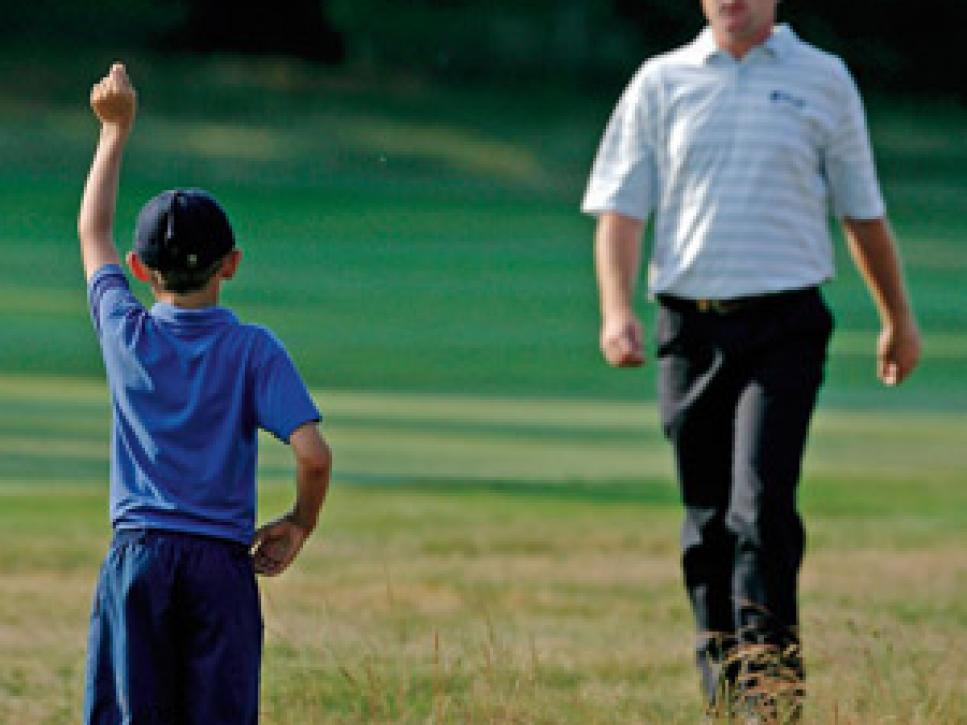A Solution To Slow Play

The latest slow-play TV campaigns (the USGA's "While We're Young!" and Golf Channel's "Hey, Knucklehead!") are amusing and educational in covering many of the time-honored tips for speeding up play, focusing on subjects such as course setup, tee-time intervals and behavioral traits of slowpokes. I like them, except for one thing: Not a word is said about the No. 1 contributor to slow play.
Wayward shots.
I guess that's to be expected. After all, hitting wayward shots is an affliction, not to be talked about in proper company except in hushed tones. No golfer wants to hit crummy, off-line shots. It's embarrassing at many levels.
We sympathize and empathize with the wayward player, even after trudging across the fairway to join in the search for a missing ball (or balls), then making the return trek, worrying about whether we might have picked up poison ivy or a Lyme tick instead of focusing on the next shot.
Searching for golf balls that might be lost, out-of-bounds or not playable (or easily playable) in the weeds, woods and water adds minutes—frequently lots and lots of minutes—to a round. One or two perfectly legal five-minute searches for a missing ball (usually a group activity) burns up more time than that wasted over 18 holes by a selfish golfer possessing a lengthy pre-shot routine who's rarely ready to play when it's his/her turn.
Even if you happen to be part of a four-ball that is enjoying a trouble-free round, you're still not immune to the effects of wayward-shot searches by players in the groups ahead of you. It's like a good driver being stuck on the interstate because of an accident three miles ahead.
Offering solutions—and "play better" ain't one of them—to this malady is like trying to catch the wind. So, I'll limit myself to just one tip that can speed up play and promote our sport, at relatively little cost.
Hire forecaddies (aka ball spotters) instead of rangers. Pace-of-play rangers (including assistant golf professionals who have got to just love this thankless task) roaming around in golf carts tend to be a waste of time, effort and money. They're rarely given any authority to take action (not their fault) or—just as bad—are officious.
Better to hire a bunch of kids as spotters each day and position them in the areas (on all 18 holes, if necessary) where wayward shots tend to collect. If that means having 20-25 spotters on the course throughout the day, go for it. It's a swell way to introduce kids to the game while giving them a chance to earn a few bucks. Make practice-range privileges and basic golf lessons part of the pay package. And work out an arrangement where the ball spotters can play holes 7-9 or 16-18 early each morning before the first groups of paying golfers reach these holes.
The effects on the golf-course maintenance crew's work can be sorted out with little fuss.
The cost of a comprehensive ball-spotter program is cheap compared to customer/club member satisfaction benefits that will come from a markedly improved pace of play.
A final note: As an amateur film critic, I have an issue with the USGA's Arnold Palmer/Clint Eastwood commercial that ends with Arnold, after delivering the iconic Rodney Dangerfield "While we're young!" line, flinches a bit and adds "Please?" after being stared down by Clint. I believe I can speak for all golfers (including Academy Award-winning director Mr. Eastwood) in saying that The King doesn't back down to anybody on the golf course. Request to the USGA: Re-do the commercial to have Dirty Harry—or is it the Man With No Name from the spaghetti westerns?—grovel ("Yes, sir, Mr. Palmer; sorry, Mr. Palmer!") while racing away from the tee.